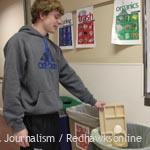Small steps can save big bucks on the school’s energy bill
By Pauline Ojambo
Talon staff writer
Walking in from the cold Minnesota weather it’s reassuring to know that as soon as you step through the commons, you’ll be greeted with the warmth of the heaters. While sitting in class taking notes, the lights above you are always shining to help the visibility and environment of the room. But have you ever wondered about the cost of keeping our school warm and bright?
Here are the facts: According to Minnehaha Director of Finances and Operations Jim Wald, the North Campus spends $83,000 on electricity, air conditioning and lighting annually and the South Campus $88,400. A combined yearly total of $171,400. At the North Campus $95,150 is spent on heating compared $82,200 at the South Campus, which totals up to $178,350. Together those costs reach over $350,000. The fact that the North Campus is an older building can account for some of the difference in costs, but careless human activity is also a factor.
So what are the top ways we waste energy in our school?
According to Minnehaha Building Supervisor Curt Bjorlin, the top two energy wastes at Minnehaha include heating and electricity.
“South is control oriented,” Bjorlin said. “[They have] computer control availability,” whereas at North Campus a person can go around with a ‘computer or an iPad,’ and change the temperature of a room with a click of a button.
There are many ways we as students can help save money for our school. In fact, there is one thing we have already been doing. Organic recycling began two years ago, and paper/cardboard recycling has been done for years. Organic items (which include food waste and paper towels) require special bags that decompose in waste facilities, but overall, “We’re saving money,” according to Bjorlin. He informed, there is a 31.5 percent tax for trash where trash is volume and requires compacting and no tax for recycling.
Minnehaha is on a tighter budget since the new high efficiency lighting was implemented.
“High efficiency costs a lot,” Bjorlin said, “but it will eventually pay back.”
The benefits of saving are greater than the costs of changing.
“The more we can save in energy, technically, the less tuition can be.” Bjorlin said.
So how can we as students help conserve energy?
“Don’t block doors open,” said Wald. It’s not just the matter of saving energy but also security. Wald also added students can “turn off lights in unoccupied areas.”
“I think overall saving energy is good. There is no harm done by it,” said junior Derek Matson. “It helps cut down on pollution and everyone’s energy bill.”
At the South Campus, students are given instructions on how to recycle. People standing by the bins to help students place the right objects in the correct containers. In the Upper School students are left with that responsibility. Posters are placed up in the lunchroom area and on each recycling bin, that shows what objects are placed where.
Overall, we as a school are doing “okay” on recycling, according to Bjorlin but there is definitely room for improvement. So every time you see a light on in an unoccupied area, turn it off. Everytime you need to get cell phone reception, walk outside instead of holding the door open. Remember the more saved, the more benefited.

